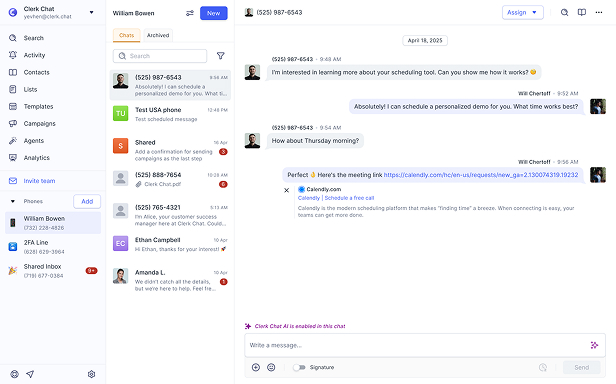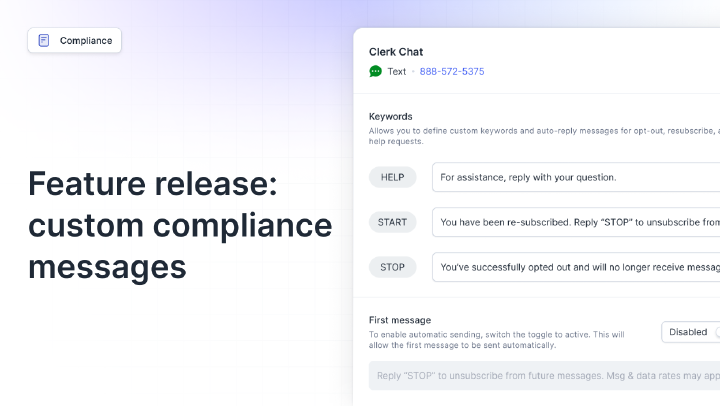SMS
[ɛs ɛm ɛs]SMS (Short Message Service) is the standard text messaging protocol that enables sending 160-character messages between mobile devices through cellular networks. Unlike internet-based messaging apps, SMS works on any phone with cellular service, reaching 5+ billion users globally with 98% open rates.
Why SMS Matters
SMS has become the backbone of modern business communication, delivering unmatched reliability and reach. While newer messaging platforms require smartphone apps and data connections, SMS works instantly on every mobile device manufactured since the 1990s. This universal compatibility makes SMS the only messaging channel that truly reaches everyone, from tech-savvy millennials to seniors with basic phones.
The impact on business metrics speaks volumes. Companies using SMS report 98% message open rates within three minutes, compared to email’s 20% open rate over 24 hours. This immediacy translates into real business outcomes: appointment-based businesses reduce no-shows by 30%, retailers see 25% sales increases from SMS campaigns, and customer service teams resolve issues 60% faster through text conversations.
Beyond metrics, SMS respects how people actually communicate today. The average person checks their phone 96 times daily, with text messages receiving immediate attention. By meeting customers where they already are—their SMS inbox—businesses create frictionless experiences that build loyalty and drive revenue.
How SMS Works
SMS operates through a straightforward yet sophisticated process that ensures reliable message delivery across global networks:
Message Creation: When you compose an SMS, your device encodes the text using GSM 7-bit alphabet (allowing 160 characters) or Unicode (70 characters for special characters/emojis).
Network Transmission: Your phone sends the message to the nearest cell tower, which forwards it to your carrier’s SMS Center (SMSC).
Routing: The SMSC identifies the recipient’s carrier through their phone number and routes the message through interconnected carrier networks.
Delivery Attempt: The recipient’s carrier attempts delivery to their device. If the phone is off or out of range, the SMSC stores the message for later delivery (typically up to 72 hours).
Confirmation: Once delivered, the recipient’s phone sends a delivery confirmation back through the network to your device.
For business messaging, platforms like Clerk Chat integrate with carrier networks through APIs, enabling features like bulk sending, scheduling, and analytics while maintaining the same reliable delivery infrastructure. Modern SMS can also concatenate multiple 160-character segments into longer messages that appear seamless to recipients.
Best Practices with SMS
Obtain Explicit Consent - Always secure written opt-in permission before sending any SMS. Use clear language explaining message frequency and content type. Store consent records with timestamps for compliance.
Identify Yourself Immediately - Start every message with your business name or recognizable short code. Recipients should know who’s texting them within the first 10 characters.
Keep Messages Concise and Actionable - Write messages under 160 characters when possible. Include one clear call-to-action and avoid multiple links or complex instructions that frustrate mobile users.
Time Messages Thoughtfully - Send between 9 AM-8 PM in recipients’ time zones. Schedule appointment reminders 24-48 hours ahead, and promotional messages during business hours for maximum engagement.
Provide Easy Opt-Out Options - Include “Reply STOP to unsubscribe” in promotional messages. Process opt-outs immediately and confirm with a final message acknowledging their request.
Segment Your Audience - Group contacts by preferences, purchase history, or engagement levels. Targeted messages achieve 3x higher conversion rates than generic broadcasts.
Monitor and Optimize Performance - Track delivery rates, open rates, click-throughs, and opt-outs. A/B test message content, timing, and frequency to improve results continuously.
Real world examples
- Healthcare
Reduced no-shows by 30% through appointment reminder texts
Read more - Retail
Increased sales 25% with targeted promotional SMS campaigns
Read more
Common misconceptions
Modern SMS can chain multiple messages together, allowing longer texts to appear as one seamless message.
SMS has a 98% open rate and remains the most direct way to reach customers instantly.
Permission-based SMS with valuable content actually increases customer satisfaction and engagement rates.
Over 60% of consumers prefer SMS for business communications like appointments, orders, and support.
Related terms
In this article:
Ready to use your business number for text messaging?
Thousands of businesses are already experiencing the power of conversational messaging through SMS. Join us. Free trial and paid tiers available.
Get StartedFAQ
Have questions? We've got answers.
Find what you need quickly and clearly with our most frequently asked questions.
SMS (Short Message Service) is a text messaging protocol that sends messages directly through cellular networks without requiring internet connectivity. Unlike WhatsApp or iMessage which need data connections, SMS works on any mobile phone with cellular service, making it universally accessible with 5+ billion users worldwide.
To set up business SMS, you'll need a messaging platform like Clerk Chat that connects to your existing business phone number. The setup involves registering for 10DLC compliance, configuring your sender ID, importing contacts with proper opt-in consent, and creating message templates. Most businesses can be operational within 24-48 hours.
SMS costs typically include a monthly platform fee ($25-500 depending on features) plus per-message charges ($0.01-0.05 per segment in the US). International rates vary by country. Volume discounts often apply for high-volume senders. Consider that SMS delivers ROI through improved customer engagement and operational efficiency.
SMS achieves 98% open rates within 3 minutes versus email's 20% open rate over 24 hours. SMS works best for time-sensitive, action-oriented messages under 160 characters, while email suits longer, detailed content. Most successful businesses use both channels strategically based on message urgency and content type.
Business SMS must comply with TCPA regulations requiring explicit opt-in consent before messaging. Messages need clear sender identification and easy opt-out instructions (typically replying STOP). 10DLC registration is mandatory for US businesses using local numbers. Violations can result in fines up to $1,500 per message.
Send SMS between 9 AM-8 PM in recipients' time zones, avoiding early mornings and late evenings. Limit promotional messages to 2-4 per month while transactional messages can be sent as needed. Monitor unsubscribe rates - anything above 2% suggests oversending. Always provide value in each message to maintain engagement.




